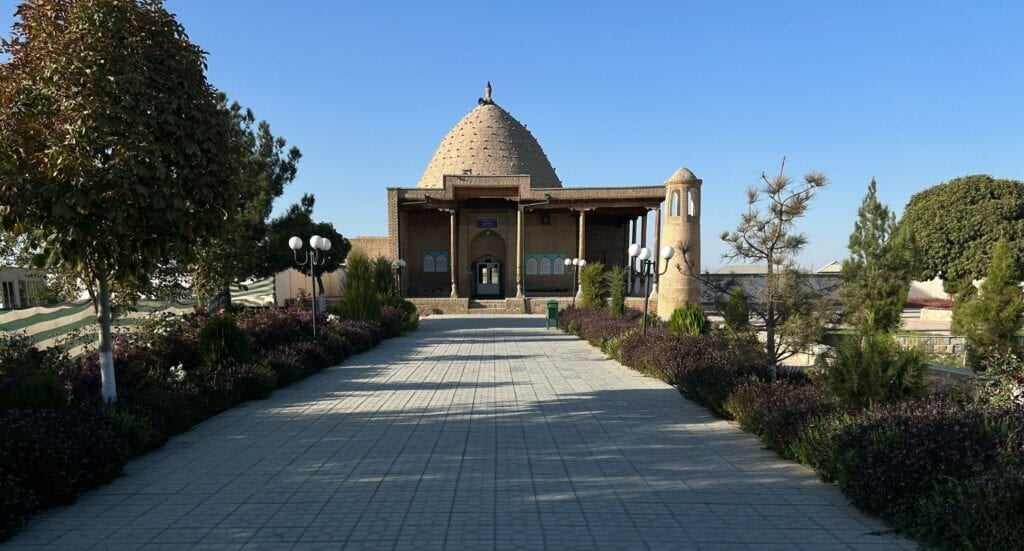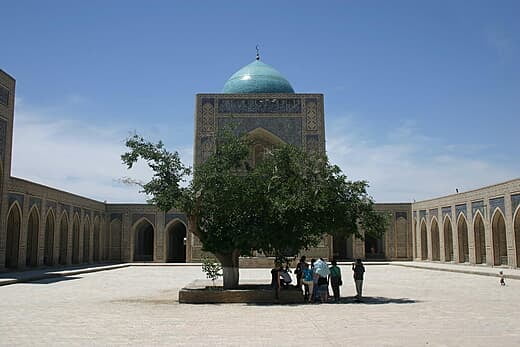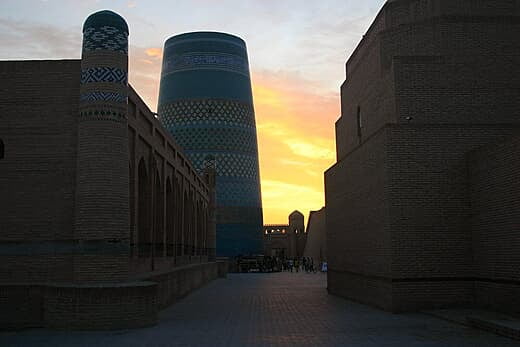2025 Silk Road Odyssey: The Trek to Central Asia
At a Glance
- October 5-18, 2025
- 14 Days
Itinerary
October 5 | Istanbul | D
After a day of travelling, arrive in Istanbul and make your way to the hotel. Take part in a tour orientation to get to know your tour leader and travel companions.
October 6 | I stanbul | B, D
Built under the direction of Byzantine Emperor Justinian I and dedicated in 537 C.E., the Hagia Sophia Grand Mosque is an architectural gem featuring great marble pillars, domes, and stunning windows. Across the way, the still-functioning Blue Mosque gets its name from the blue tiles that cover the interior walls. See the ancient underground Basilica cistern. While on a Bosphorus cruise, see some of the iconic sites of Istanbul, including the Golden Horn, a horn-shaped estuary that links the Bosphorus Strait and the Sea of Marmara. Later, take a stroll through an Egyptian Spice Bazaar.
October 7 | Tashkent | B, D
Continue touring houses of worship as you visit the Mosque of Suleiman the Magnificent—one of the most beautiful and majestic of the Imperial mosques. Newly renovated, it features a great dome, gorgeous stained glass and ornately carved wooden doors. Enjoy a stroll through the historic Greek neighbourhood of Fener (Phanar) where its labyrinthine streets are lined with old wooden mansions, churches and synagogues that date back to the Byzantine and Ottoman periods. Here, we will also visit the Orthodox Liturgy in the Patriarchal Cathedral of St. George, which for Orthodox believers is the equivalent of St. Peter in Rome for Catholics. Nearby is Balat, the historic Jewish Quarter that, during the Byzantine and Ottoman times, epitomized the climate of inter-religious coexistence that has always characterized this city. The last site of the day is the Steel Church of Bulgar.
October 8 | Tashkent | B, D
Start your day in the air, on an early morning flight to Tashkent. Tashkent is the ancient capital of Uzbekistan, where Mennonites migrating from Russia on the “Great Trek” spent the winter of 1880-81. Take a tour for a glimpse of this city’s modern sites and hear about its 2,000-year-old history. Catch glimpses of Independence Square and view an ancient Quran in the Hazrati Imam mosque. John will read from historic “trekker” journals and talk about the Mennonite experience. During dinner in a Krgiz dzurta, (a traditional yurt), we will enjoy traditional cuisine, interfaith dialogue and explore Uzbek cultures and worldviews.
October 9 | Samarkand | B, L, D
Today, we travel through the Zarafshan Valley that impressed Mennonite farmers in 1880 and continue along the Silk Road to Samarkand: one of the oldest cities in the world, known as the Pearl of the East. Marvel at the city’s famous madrasahs, minarets, and, of course, the celebrated Mausoleum of Tamerlane which is richly decorated with carved wood and mosaics. See the Ulugbek Observatory, an important research site built in the 1420s, which helped ancient astronomers predict eclipses and calculate the length of a stellar year to be 365 days, 6 hours, and 10 minutes. View the Registan, a former public square dominated by three distinctive Islamic madrasahs. Evening engagements may include a conversation on intersections of faith traditions with local people of faith.
October 10 | Samarkand
Enjoy another day in Samarkand to explore more of the sites. Visit the famous silk paper mill to see manual papermaking production in an ancient traditional style. Visit other sites as time permits, such as a carpet factory, Prophet Daniel’s tomb, Siab bazaar, and the Afrosiab museum and settlement.
October 11 | Navoi
Today, drive to Zirabulak, where Mennonites were hosted by local Muslims while stranded for nine months. Spend the day with our friends Sunnat-bobo and Sofia-bibi in their family compound, and savour their generous hospitality. Hear of Sunnat’s great-grandfather’s interaction with the foreign wagon-training Mennonites. Visit the Kyk-Ota Mosque, which was shared with the Mennonites who worshipped, baptized, married, and held funerals here.
October 12 | Bukhara | B, L, D
Relax on the drive from Samarkand to Bukhara. Take a walking tour of the city, founded in 500 BCE. It was once the centre of trade, scholarship, culture, and faith. During the golden age of the Samanids in the 9th and 10th centuries CE, Bukhara became the intellectual centre of the Islamic world. See well-known sites like the Ismail Samani Mausoleum in Samani Park, and the Chashma-Ayub Mausoleum. Walk to the Ark, a massive fortress that contains a small town. Visit the Citadel of Bakhara and learn of its importance to the Mennonite Story. See the Kalan Minaret, as well as ancient madrassahs and mosques. Visit the Juma Mosque and the Reception and Coronation court where Mennonites petitioned the Khan for permission to settle in his territory. Experience the first shopping malls of the Silk Road, the multi-domed markets along the route where merchants led their camels. Spices, silk scarves, carpets, woodcarvings and jewelry are available to purchase in these ancient domes. For dinner, savour authentic Uzbek cuisine and then enjoy a cultural show in an ancient caravanserai. Enjoy a dinner of authentic Uzbek cuisine and a cultural show.
October 13 | Bukhara | B, L, D
Enjoy another day of exploration in Bukhara. Visit Sitorai Mokhi-Khosa, the former summer residence of Bukhara’s last emir, unique for its combination of Oriental and Russian Architecture. Later, visit the Bahouddin Naqshband ensemble, the famous Sufi shrine and Chor-Bakr Necropolis.
October 14 | Khiva | B, L, D
Today, depart this ancient city for another one, Khiva. We travel through the Kyzylkum (Red Sand) Desert to the ancient walled city of Khiva – one of the most remote cities along the Silk Road. From the comfort of our coach, we will learn about the struggles that the Mennonite trekkers endured as they crossed this harsh landscape. In Khiva, learn about and discuss significant contributions made by Muslim scholars such as Abū ‘Abdallāh Muḥammad ibn Mūsā Al-Khwārizmi, a Persian intellectual born around 780 who is credited as the founder of algebra.
October 15 | Khiva | B, L, D
Our day begins with a short drive to Ak Metchet, a quaint village where Mennonite families were invited to settle after enduring raids by the Turkoman tribes. Ak Metchet is now being developed into a tourist destination that celebrates the 51-year harmony between Mennonites and Muslims before the Mennonites’ deportation in 1935. Before departing Ak Metchet, make a stop at the Khan’s summer palace. Return to Khiva in the afternoon to visit the increasingly celebrated Ichan-Kala Mennonite Museum. The new manager is collecting contributions to add more artifacts. Visit the Nurullabai Palace that Mennonite craftsmen helped build for Muhammad Rakimkhan II, the penultimate Khan of Khiva, whom Mennonites appreciated.
October 16 | Khiva | B, L, D
We continue our exploration of Khiva to learn about the history of Mennonites who lived here. This evening, you may choose to attend a cultural show at a summer palace.
October 17 | Tashkent | B, L, D
After a flight back to Uzbekistan’s capital, freshen up, rest, walk the streets or browse local shops at your leisure. Later, learn how to make delicious Uzbek food over fire and coals at a cooking class. Get dressed up in traditional outfits (and Eastern makeup for the women) and pose for photos! Share final reflections and bid your fellow travellers farewell over your final meal together.
October 18 | B
Depart for home.
Frequently Asked Questions
Please note: itinerary subject to change.
For further information, please contact us. We would be happy to be of assistance.















